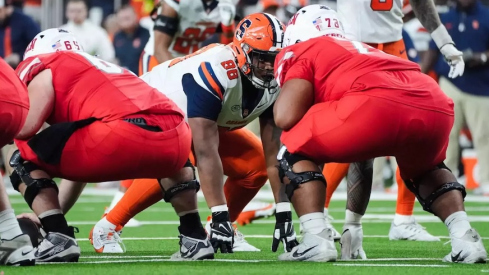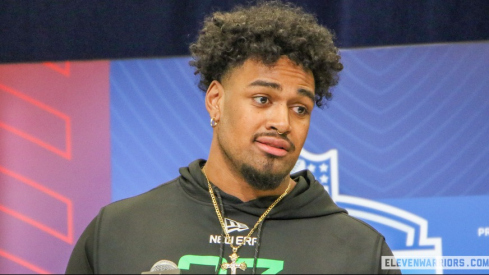
After using last week to examine the Buckeyes' first spring practice, I return to analyzing Urban Meyer and Tom Herman's Ohio State's offense.
In my previous post I examined OSU's base run game. Today I want to look at the complementary aspects of the Buckeye run game. These plays both protect the base schemes as well as exploit a defense overplaying the Buckeyes' bread and butter plays.
Outside Zone
Unlike many spread (and pro) teams, outside zone is undoubtedly a complementary play for Urban Meyer and Ohio State. OSU generally only runs the play when the defense presents an advantageous opportunity.
The Buckeyes run outside zone with one of two looks. They will give to a back, generally off of rocket motion from the slot. OSU's primary use of outside zone, however, is as a direct snap lead play to Braxton Miller.
The play works in connection with inside zone read. The pre-snap back alignment is the same. If a defense uses a scrape exchange — a common tactic against inside zone — outside zone takes advantage of it. The defensive end crashing takes himself out of the play. OSU can then lead up on the scraping outside linebacker, and the QB can cut up field through the seam.

It is also a straightforward way to get a numbers advantage by using the halfback as a lead blocker. And it has the added advantage of getting Miller outside contain.
For the offensive line, the outside zone covered/uncovered principles are the same as with inside zone. But the technique is different. The line will lateral or 'bucket' step playside. Rather than work in tandem through the defensive line to the linebackers, the linemen want to reach the next playside defensive linemen. If a defensive lineman continues moving laterally, however, the offensive lineman will simply ride him to the sideline and create cut-up lanes.
Speed Option
I categorize two different looks as 'speed option.' A traditional speed option play:
As well as option off inside zone read, what is sometimes referred to as a 'straddled option.'
The reason I lump both together is that they are both one option read off the first alley player, in contrast to triple option. Straddled option is not a true triple option because inside zone read is not a true option. Once the QB gives, the play is dependent upon the inside zone blocking.
In any event, both looks are an inexpensive method to get outside against a defense overplaying inside run plays. I say 'inexpensive' because it takes little additional learning from the offense. In particular, there are no additional blocking schemes to learn. With speed option, the offensive line blocks outside zone. With straddled option, the line blocks inside zone read. The play just attacks away from the blocking scheme.
A single option for the QB also takes less practice time than learning a triple option scheme. Both option looks are therefore relatively easy methods to attack the edge and act as a constraint against teams cheating alley defenders into the tackle box.
'Belly' Zone
Belly simply refers to inside zone towards the halfback side. I use belly because it's similar to the old belly dive play to the fullback. It also serves to differentiate it from the base inside zone read play, which goes away from the halfback. With belly, halfback generally lines up deeper pre-snap. The play hits quickly, immediately attacking the playside B gap.
OSU often uses the play when they have a lead and want to run down the clock. But the play is also effective when a defense is excessively focused on slanting away from the halfback to contain the inside zone read play. It also works when teams vacate linebackers or safeties to contain the quarterback. The play quickly hits right where those defenders left. It is a good change-up to a defense that is trying to take advantage of the Buckeyes' tendencies.
Jet Sweep
The jet sweep is not so much a play as much as an add-on that constrains the defense. In particular, Meyer likes to run a jet sweep (or jet sweep fake) away from the base run blocking. He will do so with both zone and gap blocking. In either case, the goal is to exploit an overpursuing defense to break contain away from pursuit.
By using the jet sweep, OSU hopes to slow the linebackers from overpursuing. OSU can then fake a jet sweep to force a defense to play straight up versus their inside run plays.
Sweep Read
The Buckeyes also use the sweep read. This combines an old pin and pull sweep play with a read of an interior defender, normally a 1 technique nose tackle. The play takes advantage of the read concept while generally ensuring that the QB does not have to keep and the play goes outside.
The read eliminates one defender the offense has to block. This allows two offensive linemen — generally the playside guard and center — to pull and lead the halfback. But by reading an interior defender, the QB is less likely to keep, because that defender is not used to being read and will therefore attack the quarterback. For Ohio State, the interior read also takes advantage of defensive tackles that are overly aggressively playing the Buckeye inside run game.
In sum, it is not difficult to see that the Buckeyes' constraint run game attacks the edge. This is by design. OSU's base run game is zone and gap plays between the tackles. By building the outside plays off the inside run game, OSU can get easy opportunities to get athletes in space versus teams overly focused inside. In turn, OSU can threaten the defense at the edge to slow down a defense's pursuit against its base inside run plays.
Next week I will begin examining the Ohio State passing offense.

